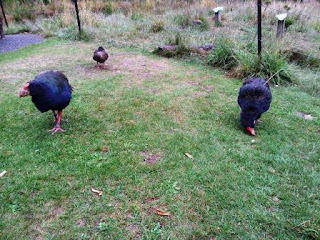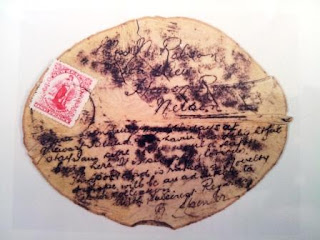We set off a little earlier than usual to ensure we would be in place when the kiwi started to emerge from their burrows.
The takahe are at the bottom of either steps or a steepish slope so the support guide went on ahead and convinced T2 and Puffin to have their supper at the top of the slope. Food being pretty much the number one thought in takahe brains they were most obliging and were in place by the time the rest of us arrived.
We then headed up to wait for the kiwi and Flip Flop in particular. Again we were lucky and Flip Flop wandered by in front of the person in the wheelchair giving everyone a good look. I had been positioned in a different spot and was making my way back when Flip Flop decided to meet me head on on the bridge. I moved to the right and stood stock still as I knew Flip Flop is a creature of habit - he always sticks to one side of the bridge. He stomped on by not seeming to register my close presence and I breathed a sigh of relief that I had not scared him off.
We then headed down Te Mahanga track, going carefully. As guide dogs are not permitted in Zealandia, our blind visitor was supported by a friend.
 |
| A tuna or long finned eel |
We stopped by the eel pool. We have been encouraging the long finned eels or tuna of the river to become a little more visible and at last they are obliging. We could see a medium sized eel lazily drifting about when we shone our torches into the water. This endemic species is becoming rarer as many of our rivers have become compromised by dairying and they are still unprotected from fishing.
They have an interesting life cycle as to breed they have to swim many thousand kilometres to trenches off the island of Tonga. They do this at the age of between twenty five and eighty years and undergo a physical change before they set out. Their gut pretty much disappears, their head becomes narrower and they do not eat during the journey. Once they have bred it is the end of their life cycle and they die. Their progeny do not look anything like eels but are flat and leaf shaped. They drift with currents to make the long journey back to New Zealand's rivers and streams. Once here they undergo another change and turn into elvers, which are more eel shaped. They are great climbers and can clamber up waterfalls of up to 20 metres.
 |
| tuna larvae showing development to elver. |
Here is a link to a clip on tuna
http://www.youtube.com/watch?v=0fdtYEqEqC0
We continued on to see the frogs. It was interesting to watch sign language happening under torch light. Red light shining on hands worked pretty well.
We finished the tour by visiting the tuatara as well as seeing a few more kiwi along the way. As it is so dry we hear them easily in the bush at present which makes for plenty of sightings.
Back in the visitors centre we discussed how things had gone. The group promised to give us more detailed feedback but basically a good evening was had by all.













.jpg)















.jpg)












